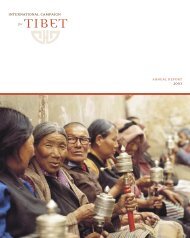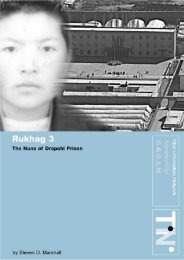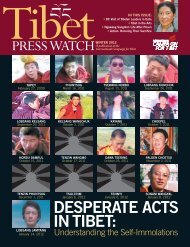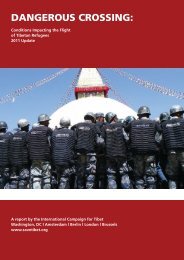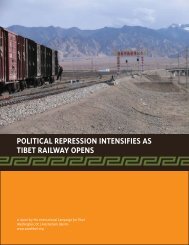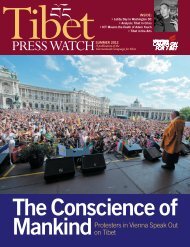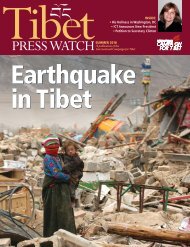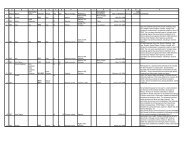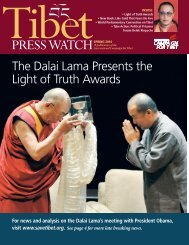download the report - International Campaign for Tibet
download the report - International Campaign for Tibet
download the report - International Campaign for Tibet
Create successful ePaper yourself
Turn your PDF publications into a flip-book with our unique Google optimized e-Paper software.
INTERNATIONAL CAMPAIGN FOR TIBET<br />
‘SMASHING THE SPLITTIST CLIQUE’:<br />
AN ANALYSIS OF LEADERSHIP INVOLVED<br />
IN THE CRACKDOWN<br />
THE PROTESTS AGAINST CHINESE RULE that broke out in <strong>Tibet</strong> in March 2008 put<br />
<strong>the</strong> Chinese government and its administration of <strong>Tibet</strong> under some of <strong>the</strong><br />
most intense scrutiny it has had to face in decades. However, little is reliably<br />
known about which individuals and institutions in <strong>the</strong> People’s Republic of China<br />
(PRC) are ultimately responsible <strong>for</strong> <strong>for</strong>mulating and implementing government policy<br />
in <strong>Tibet</strong>. Instead, China’s complex and factionalized power structures are almost<br />
entirely opaque on <strong>the</strong> question of <strong>Tibet</strong>, and <strong>the</strong> relevant government and Chinese<br />
Communist Party (CCP) officials remain entirely unaccountable to <strong>the</strong> <strong>Tibet</strong>an people<br />
<strong>the</strong>mselves. This is partly because of <strong>the</strong> strong hold of <strong>the</strong> military over <strong>Tibet</strong>,<br />
and <strong>the</strong> latent power struggle between military and civilian elites, which is a perennial<br />
feature of PRC politics.<br />
Beijing’s official explanation <strong>for</strong> <strong>the</strong> protests in March 2008 and beyond is that <strong>the</strong>y<br />
were planned by <strong>the</strong> “Dalai clique” and “hostile anti-China <strong>for</strong>ces” abroad, and carried<br />
out with <strong>the</strong> intention of “splitting China” by people in <strong>Tibet</strong> who had been<br />
“fooled” by <strong>the</strong> Dalai Lama, in particular a “tiny minority” of monks who are described<br />
as “<strong>the</strong> scum of Buddhism” and <strong>the</strong> “loyal running dogs of <strong>the</strong> Dalai clique”.<br />
The Chinese leadership’s refusal to publicly consider <strong>the</strong> possibility that <strong>the</strong> unrest in<br />
<strong>Tibet</strong> could be due to broad dissatisfaction among <strong>Tibet</strong>ans — or even to concede that<br />
<strong>the</strong> unrest has its roots in <strong>Tibet</strong> itself — has not enhanced its credibility with Western<br />
and some o<strong>the</strong>r Asian governments. Indeed, <strong>the</strong> calls from <strong>for</strong>eign governments urging<br />
China’s leadership to enter into substantive dialogue with <strong>the</strong> Dalai Lama on<br />
<strong>Tibet</strong>’s future is at least a partial acknowledgment by Western leaders of <strong>the</strong> shortcomings<br />
and failings of China’s policies in <strong>Tibet</strong>, as well as an implicit acknowledgment<br />
of <strong>the</strong> Dalai Lama as <strong>the</strong> pre-eminent representative of <strong>the</strong> <strong>Tibet</strong>an people.<br />
Within China, <strong>the</strong> concept that <strong>the</strong> <strong>Tibet</strong> issue is merely an ‘internal affair’ has been<br />
profoundly challenged, both among Chinese intellectuals and governments worldwide<br />
— particularly given Hu Jintao’s public emphasis on projecting <strong>the</strong> image of<br />
China’s ‘peaceful rise’ and its ‘harmonious society’.<br />
While <strong>the</strong>re is clearly serious debate behind closed doors, and some speculation that<br />
93



